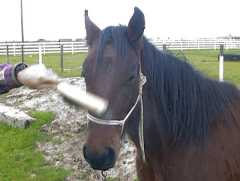|
Over millions of years Mother Nature has programmed horses to avoid
unsettling situations. If a horse is not sure of an object or animal,
his instinct is to study it from a distance. A certain level of stress
is naturally generated. Unless the horse processes the object and decides
it is non-threatening (whereupon his confidence in his perception suppresses
his flight stress) the horse is stimulated until he reaches the point of
flight. In order not to be eaten by predators, the horse's first instinct
has had to be, "If in doubt, get out!"
The successful wild horse gentler understands the nature of the horse. He/she
sets up non threatening and non confrontational scenarios where the horse can calmly
consider the human and develops some confidence that at least this particular
human does not pose a mortal threat.
Each horse will respond differently based on its own past experiences and level
of background stress. With some horses you can move around the pen in a non-threatening
manner and the horse will begin to check you out. Others may start to move away frantically
with any movement on the handler's part in which case sitting quietly in a chair reading a book
may be a more appropriate approach. How you approach your particular horse should be
based on how your horse responds to your presence.
|
The horse has to decide to
approach the human
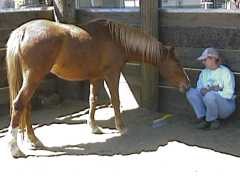
Generating curiosity in a horse
that can't be touched
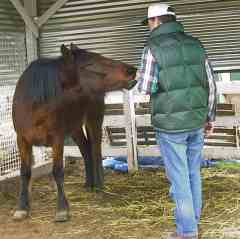
|
|
|
BASIC GENTLING APPROACHES:
| |
|
USING A BAMBOO POLE
|
|
If your horse won't let you close without running away,
how are you going to teach it to accept your touch?
One practical method involves using a bamboo pole. The pole
allows you to make first contact from a distance
where your presence doesn't seem so overpowering to the horse.
Effective use of the pole involves approaching quietly and
making the contact feel good. The ridges on the pole allow
the horse to feel like he's being groomed by another horse
when the pole is moved across his back. This approach can trigger
the horse's curiosity, the first step in accepting the situation.
|
Making first contact with a pole
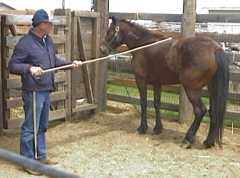
|
|
|
BASIC GENTLING APPROACHES:
| |
|
USING A SLIDING NECK LOOP
|
|
It's cool to see the demonstration trainers deftly throwing a rope
over a horse's head and working it in the round pen. A rope is handy
when used correctly as it can be used to ask the horse to come in
towards the handler. However when used on a horse that has a very flighty
horsenality or if the rope is misapplied, things can become pretty frantic.
Additionally, the average adopter doesn't have enough skill to quietly and
accurately toss a loop over the horse's head without provoking a flight response.
We recommend using a sliding neck loop which can be quietly placed on the
horse using the bamboo pole, and can be used much the same as a neck rope except
more safely. Most importantly the sliding neck loop can be instantly released from the horse
if the situation accelerates beyond the handler's control. The sliding neck loop
can be made from standard kernmantle braid poly rope available from a variety
store such as WalMart.
|
The sliding neck loop can
be applied quietly and safely

The loop can be adjusted so that it
holds the horse but doesn't choke.
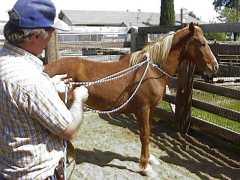
|
Important Note: If you take on the project of developing an untrained horse, everybody will want to give you advice. Don't act on any advice, including the ideas offered in this site, unless it makes sense to you and fits your individual situation. Your abilities and the sensitivities of your horse(s) may differ from the examples given. Be alert and rational with your actions so neither you nor your horse will get hurt. This information is offered as illustrations of what we do and the reader must apply common sense since he or she is solely responsible for his or her actions.
Happy trails!
Press Back to return to the page which brought you here
KBR Horse Training Information, © 2000 Lamm's Kickin' Back
Ranch and Willis & Sharon Lamm. All rights reserved. Duplication of any of this material for
commercial use is prohibited without express written permission. This prohibition is
not intended to extend to personal non-commercial use, including sharing with others for
safety and learning purposes, provided this copyright notice is attached.
Email us to submit comments or request reproduction
permission.
|
